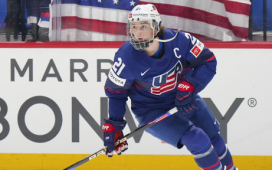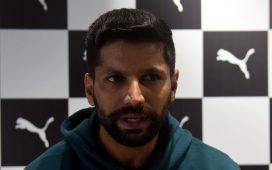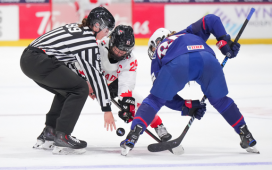Welcome to the World Cap of Hockey, a new series that dives into international waters and projects what a tournament featuring six national team rosters would look like today if each national team was required to be compliant to the NHL’s salary cap structure.
The six teams in this series will be Canada, USA, Russia, Sweden, Finland and a group consisting of top Europeans from nations such as Slovakia, Switzerland and the Czech Republic, and each roster must fit under the current $81.5-million cap hit using only players currently under NHL contract.
Today, we break down Team USA.
Decisions, decisions.
This topped it all. By far, the hardest team to assemble to date. Three of the nation’s top forwards – Auston Matthews, Patrick Kane and Jack Eichel – make at least $10 million, and investing $32 million in three players just wasn’t going to cut it without making cuts elsewhere. And that was the biggest dilemma: do you sacrifice your team’s depth to ensure you have a select few players? It wasn’t easy, but yes.
So that meant digging deep to find the best value around the league. Sorry, Johnny Gaudreau and Brock Nelson, but roughly $6 million each meant an early trip to the chopping block. J.T. Miller’s $5.25-million hit is tremendous value for Vancouver, but not on a team full of star players. Defensemen Torey Krug and Zach Werenski would be dynamos on a real national team, but with other inexpensive options available, they were next to be cut. Other notables that would have made the team in a proper tournament include Blake Wheeler, Jake Guentzel, Max Pacioretty, Ryan Suter and Jaccob Slavin, but rules are rules. You can’t bend the salary cap.
But it wasn’t just those players who needed to be left off the club. No, if the Americans were going to fit under the cap, there was going to need to be a drastic omission. In this case, Matthew Tkachuk. His $7 million cap hit suits him well in Calgary and he’d be a first-line winger on the team in real life, but, again, that’s the cost of doing business. His younger brother, Brady, would have hit 50 points as a sophomore on an entry-level contract, so he was an easy replacement.
Building the top six was easy, but finding the best value deeper in the lineup was the next task. That’s what made keeping the Matthews-Eichel combination even more challenging – they’re obviously vital to the team, but would one actually have to go? There’s a certain threshold where you simply can’t replace a high-value player for someone cheaper (Alex Iafallo and his $2.43-million hit would have been a solid addition) and shaving off a few millions along the way wasn’t going to work, either.
Because of the cost-cutting up front, Krug’s $5.25-million hit was replaced by John Marino’s $925,000 entry-level contract – it’s a good thing the Americans have an abundance of talented, young defensemen. The emergence of Marino, Quinn Hughes and Adam Fox this year is a sign of great things to come for the Americans. In 2022, they’d all have a good shot at making the Olympic team, if the NHL was to actually go. Seth Jones and John Carlson are the pillars of this squad and were untouchable, but leaving off Werenski was a tough pill to swallow.
Moving on to the goaltending situation, there was a blessing in disguise. Connor Hellebuyck has been the NHL’s best goaltender this season and leaving him off borders on a travesty, but can you go wrong with Ben Bishop? Bishop was a finalist for the Vezina Trophy last year and when he’s at his best, few can match ‘Big Ben’. There’s a $1.25-million cap gap between Bishop and Hellebuyck, so while nickel and diming elsewhere hasn’t been effective, it worked in this situation. Alex Stalock was an unheralded star in Minnestoa before the break and Jack Campbell is a reliable backup goalie, so while it’s not the best goaltending trio out there, it’s more than capable of stealing victories.
The important thing here is that when you need to win, you need your best players. Of the top 15 American forwards in league scoring, 10 of them didn’t make it. But that’s the cost of keeping the best players. It’s a challenge having to devote such a large cap hit to just three players, but Eichel or Kane will bring a team much more value than Larkin or Miller. The former two are among the best players in the league for a reason – you just can’t leave them off. But it takes a toll on the rest of the lineup – this is far from the best version of the American national team, but the best under the cap-compliant circumstances.
Here is the full Team USA World Cap of Hockey roster:
Forwards
Alex DeBrincat – Auston Matthews – Patrick Kane
Kyle Connor – Jack Eichel – Brock Boeser
Brady Tkachuk – Clayton Keller – Bryan Rust
Conor Garland – Blake Coleman – Kevin Labanc
Kailer Yamamoto
Defense
John Carlson – Quinn Hughes
Seth Jones – Kevin Shattenkirk
Adam Fox – Tony DeAngelo
John Marino
Goalies
Ben Bishop
Alex Stalock
Jack Campbell
Total cap hit (Per CapFriendly): $80,928,522
Want more in-depth features and analysis? Subscribe to The Hockey News magazine.








